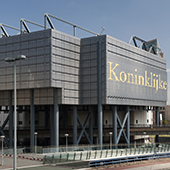The National Library of the Netherlands is a small institution that plays a large role in the world of digital preservation. The library (known in Dutch as the Koninklijke Bibliotheek (external link) and more commonly as the KB) is a leader in supporting practical approaches to preservation through research and collaboration.

The National Library of the Netherlands (Koninklijke Bibliotheek)
In 2003, the KB launched its e-Depot (external link) for the long-term management of electronic journal literature. e-Depot is closely tied to the digital life cycle and one of its key features involves agreements with publishers for direct transmission of content to the library's preservation environment.
Now, seven years and 15 million articles later, the KB is building on the success of e-Depot. "I think the seven-year itch is bothering us now," said Hilde van Wijngaarden, head of acquisitions and processing at the KB. "We are ready for a next-generation system."
The KB intends to become a large-scale digital library, networked with other institutions in the Netherlands. Their ambitious strategic plan for 2010–2013 (external link) outlines a number of objectives, such as, "We offer everyone access to everything published in and about the Netherlands," and, "We guarantee long-term storage of digital information."
In the meantime, e-Depot remains a model electronic deposit system, though van Wijngaarden says that the KB has come a very long way since 2003. "At that time, we didn't know precisely what tools or preservation functionality would be needed to keep all the objects accessible for the long term," she said.
Throughout the decade, the KB has continuously worked to improve the system. Changes in scope and ambition now call for the replacement of the current system by a new preservation and access infrastructure. The new e-Depot will have to process, store and keep available digital objects on a much larger scale and of a much more diverse nature than the current system, including websites, digitized masters, e-books and e-journals.
The new system will also include an improved ingest process, implementing the latest results of digital preservation R&D, such as JHOVE (external link) and DROID, (external link) to characterize and identify digital object types.
Van Wijngaarden says that it is wise to have a variety of preservation solutions and tools, and not rely on any single method. Together with European libraries, archives and research organizations, the KB has been working on a methodology for preservation planning in the European project PLANETS (external link). The new e-Depot environment will include a preservation planning module that allows for policy-based decision making on how to apply preservation actions. KB is doing bit-level preservation but has also prepared a format-migration module and is developing another possible preservation solution: emulation.

Hilde van Wijngaarden, Head of Acquisitions and Processing at the KB
The KB cares about preserving the look-and-feel of digital content, though there is concern that some preservation methods may cause problems in this regard. Emulation mimics or simulates the functionality of an earlier computer environment used to interact with specific digital information. One of the uses of emulation, for example, has been to imitate vintage video games by programming modern computers to recreate the original experience of playing the games as they were when they were first published.
In 2005, the KB and the Dutch National Archives started an emulation project called Dioscuri (external link), which has become part of PLANETS. Dioscuri recreates computer environments for operating systems up to 1992, which in turn permits the use of application programs, such as word processing, to recreate the look and feel of information objects from that era.
Van Wijngaarden admits that emulation has not had much popular support as a preservation strategy. She said, "We used to be 'that crazy library that believed in emulation' because most organizations believed it would be too expensive to build emulators." The KB is convinced, though, that emulation technology will be needed, not just to preserve the look-and-feel but to ensure future access to complex digital objects such as websites, scientific papers and research data. She emphasizes that it is best to use several diverse approaches to digital preservation, all with the goal of robust access to digital objects in the future.
Van Wijngaarden said that planning is a challenge for digital libraries. The basic issue is knowing with certainty what has to be done to keep information accessible for the long term. "I used to think that planning was something that you did after you stored your objects," she said. "And then you’d ask yourself, 'OK what do I need to think about to keep them accessible?'"
The work of the KB is evidence that planning—coupled with learning from real-world operations—yields good results. A critical element involves imagining the future. As van Wijngaarden said, "It may not be needed yet but it's important to plan for it."
